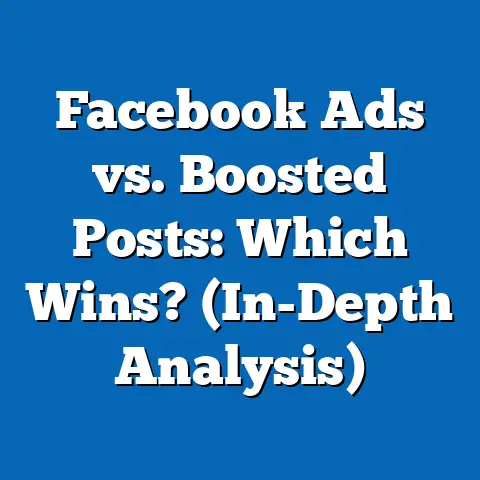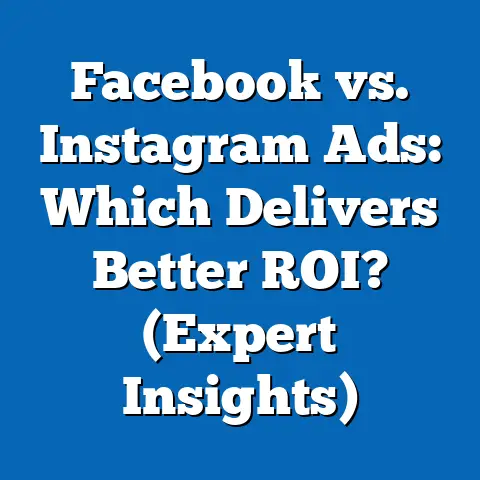Master Facebook Ads for Real Estate (Unlock Proven Success)
I’ve seen it happen time and time again. Real estate agents, eager to tap into the vast potential of Facebook, launch ad campaigns with the enthusiasm of a kid on Christmas morning. They target everyone within a 50-mile radius, thinking the wider the net, the more fish they’ll catch. But instead of a bountiful harvest of leads, they end up with a handful of irrelevant clicks and a rapidly dwindling budget. This is a classic mistake – targeting too broadly.
Many real estate professionals believe that casting a wide net will attract more potential buyers. The reality? It often leads to wasted ad spend and dismal conversion rates. I’m talking about high click-through rates that don’t translate into meaningful engagement. Clicks that don’t convert into leads. Money down the drain.
For example, I recently worked with an agent who spent $500 on a Facebook ad campaign targeting “home buyers” in a large metropolitan area. They got hundreds of clicks, but only two actual leads. Why? Because their targeting was too generic. They were reaching everyone from first-time renters to seasoned investors, none of whom were truly interested in the properties they were showcasing.
Understanding the Basics of Facebook Ads
Before diving into the nitty-gritty of targeting and ad creation, let’s lay the foundation with a clear understanding of how Facebook Ads work.
The Auction System: Facebook Ads operate on an auction system. You’re not just paying for ad space; you’re bidding against other advertisers targeting the same audience. Facebook’s algorithm then determines which ads to show based on a combination of factors, including your bid, ad quality, and estimated action rates. I always tell my clients: it’s not just about having the biggest budget, it’s about having the most relevant ad.
Relevance Score: This is where the relevance score comes in. Facebook assigns each of your ads a relevance score based on how well it resonates with your target audience. A higher relevance score means your ad is more likely to be shown, and at a lower cost. Think of it as Facebook rewarding you for creating ads that people actually want to see.
Ad Formats: Facebook offers a variety of ad formats to choose from, each with its own strengths and weaknesses.
- Image Ads: Simple and effective for showcasing properties with stunning visuals.
- Video Ads: Ideal for virtual tours, neighborhood spotlights, and agent introductions.
- Slideshow Ads: A budget-friendly alternative to video ads, using a series of images to tell a story.
- Carousel Ads: Perfect for showcasing multiple properties or highlighting different features of a single listing.
Setting Clear Goals: Before you even think about creating an ad, you need to define your goals. What do you want to achieve with your campaign?
- Brand Awareness: Introduce yourself and your brand to a wider audience.
- Lead Generation: Collect contact information from potential buyers and sellers.
- Property Showcasing: Highlight specific listings and drive traffic to your website.
Having a clear goal in mind will guide your targeting, ad creative, and overall campaign strategy.
Takeaway: Facebook Ads work on an auction system where relevance and ad quality are key. Choose the right ad format and set clear goals to maximize your campaign’s effectiveness.
Defining Your Target Audience
This is where the magic happens. I’ve seen countless campaigns go from zero to hero simply by refining the target audience. Forget the broad strokes; we’re talking about laser-like precision.
Audience Segmentation: Real estate is hyper-local and highly specific. You’re not selling “houses”; you’re selling homes in specific neighborhoods, with specific amenities, to specific types of people. That’s why audience segmentation is non-negotiable.
Facebook’s Targeting Options: Facebook offers a treasure trove of targeting options to help you pinpoint your ideal audience.
- Demographics: Age, gender, education, income, job title – these are the basics. But don’t stop there. Consider factors like marital status, family size, and homeownership status.
- Interests: What are your target audience’s hobbies and passions? Do they follow real estate blogs? Are they interested in home improvement or interior design?
- Behaviors: This is where things get really interesting. You can target people based on their online behavior, such as whether they’ve recently searched for homes, visited real estate websites, or used mortgage calculators.
- Location: This is crucial for real estate. You can target people living in specific cities, zip codes, or even within a certain radius of a particular property.
Creating a Precise Audience Profile: Let’s say you’re selling luxury condos in a downtown area. Your ideal audience might be:
- Age: 35-55
- Income: $150,000+
- Interests: Fine dining, travel, art, luxury cars
- Behaviors: Recently searched for condos online, visited luxury real estate websites
Custom Audiences: Want to take your targeting to the next level? Create custom audiences based on:
- Website Traffic: Retarget people who have visited your website but haven’t yet inquired about a property.
- Engagement with Previous Ads: Target people who have liked, commented on, or shared your previous ads.
- Existing Customer Lists: Upload your existing customer list to Facebook and target them with special offers or new listings.
Lookalike Audiences: This is one of my favorite features. Facebook can create a lookalike audience based on your existing customers, targeting people who share similar demographics, interests, and behaviors. I’ve seen lookalike audiences outperform traditional targeting options by a significant margin.
Takeaway: Ditch the broad targeting and embrace audience segmentation. Use Facebook’s targeting options to create a precise audience profile, and leverage custom and lookalike audiences to reach your ideal clients.
Crafting Compelling Ad Copy and Visuals
You’ve got your target audience dialed in – now it’s time to grab their attention with compelling ad copy and visuals. Remember, you’re competing against a sea of distractions, so your ad needs to stand out.
Engaging Ad Copy: Your ad copy should speak directly to your target audience’s needs and desires. What are their pain points? What are they looking for in a property? Use local market insights to make your copy even more relevant.
For example, instead of saying “Beautiful 3-bedroom home for sale,” try something like “Escape the city and find tranquility in this spacious 3-bedroom home nestled in the heart of [Neighborhood Name].”
High-Quality Visuals: In real estate, visuals are everything. Invest in professional photography and video tours to showcase your properties in their best light. Use high-resolution images and videos that are clear, well-lit, and visually appealing.
Call-to-Action (CTA) Buttons: Don’t forget the CTA! Tell people what you want them to do. “Learn More,” “Schedule a Showing,” “Get a Free Market Analysis” – these are all effective CTAs that can drive clicks and conversions.
Successful Ad Copy and Visual Examples:
- Image Ad: A stunning photo of a modern kitchen with the headline “Dream Kitchens Await in [Neighborhood Name].” CTA: “See Listings.”
- Video Ad: A virtual tour of a luxury condo with the headline “Experience Downtown Living at Its Finest.” CTA: “Schedule a Tour.”
- Carousel Ad: Showcase multiple properties with the headline “Find Your Perfect Home in [City Name].” Each property should have its own image, description, and CTA.
Takeaway: Craft ad copy that speaks to your target audience’s needs and desires, use high-quality visuals to capture attention, and include a clear CTA to drive clicks and conversions.
Setting Up and Managing Campaigns
Now that you have your audience and creative ready, it’s time to set up your Facebook Ads campaign.
Creating a Campaign from Start to Finish:
- Choose Your Objective: Select the objective that aligns with your goals (e.g., lead generation, traffic, brand awareness).
- Define Your Audience: Use the targeting options discussed earlier to define your target audience.
- Set Your Budget: Decide how much you’re willing to spend on your campaign. You can set a daily budget or a lifetime budget.
- Choose Your Ad Placement: Select where you want your ads to appear (e.g., Facebook News Feed, Instagram Feed, Audience Network).
- Create Your Ad: Upload your visuals, write your ad copy, and add your CTA.
- Review and Publish: Double-check everything and hit the “Publish” button.
A/B Testing: A/B testing is crucial for optimizing your campaigns. Test different ad variations to see what resonates best with your audience. Try testing different headlines, images, CTAs, and targeting options.
Monitoring Campaign Performance: Use Facebook Ads Manager to monitor your campaign’s performance. Key metrics to track include:
- Click-Through Rate (CTR): The percentage of people who saw your ad and clicked on it.
- Conversion Rate: The percentage of people who clicked on your ad and completed a desired action (e.g., filling out a lead form, scheduling a showing).
- Cost Per Acquisition (CPA): The cost of acquiring a new lead or customer.
- Return on Investment (ROI): The overall profitability of your campaign.
Takeaway: Follow a step-by-step process to set up your Facebook Ads campaign, A/B test different ad variations, and monitor your campaign’s performance using Facebook Ads Manager.
Analyzing and Optimizing Your Campaigns
The work doesn’t stop once your campaign is live. In fact, that’s when the real work begins. Analyzing your data and optimizing your campaigns is essential for maximizing your ROI.
Analyzing Data from Previous Campaigns: Look at the data from your previous campaigns to identify what worked and what didn’t. Which targeting options generated the most leads? Which ad creative performed best? Use this information to make informed decisions for future ads.
Optimizing Campaigns Based on Performance Data: Based on your performance data, adjust your campaigns accordingly.
- Adjust Budgets: If a particular ad set is performing well, increase its budget. If it’s not, decrease its budget or pause it altogether.
- Refine Targeting: If you’re not reaching the right audience, refine your targeting options.
- Update Ad Creative: If your ad creative is stale, update it with fresh visuals and copy.
Staying Updated with Facebook’s Algorithm Changes and Advertising Policies: Facebook is constantly evolving, so it’s important to stay updated with the latest algorithm changes and advertising policies. Follow industry blogs, attend webinars, and join Facebook advertising communities to stay in the know.
Takeaway: Analyze your data, optimize your campaigns based on performance data, and stay updated with Facebook’s algorithm changes and advertising policies.
Conclusion
Mastering Facebook Ads for real estate is an ongoing journey, but the potential rewards are immense. By understanding the basics, defining your target audience, crafting compelling ad creative, setting up and managing your campaigns effectively, and continuously analyzing and optimizing your results, you can unlock the potential for proven success in your real estate endeavors.
Don’t let the fear of the unknown hold you back. Start creating your first targeted Facebook ad campaign today. Experiment, learn, and adapt. The real estate market is constantly changing, and your advertising strategies should evolve with it. Remember, the key to success is not just about spending money; it’s about spending it wisely. So go out there, target your ideal clients, and watch your real estate business flourish.






